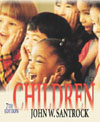John W. Santrock,
University of Texas, Dallas
| articulation disorders | problems in pronouncing sounds correctly.
(See 372)
|
 |
 |
 |
| assistive technology | various services and devices to help children with disabilities function in their environment.
(See 377)
|
 |
 |
 |
| attention deficit hyperactivity disorder (ADHD) | a disability in which children consistently show one or more of the following characteristics: (1) inattention, (2) hyperactivity, and (3) impulsivity.
(See 374)
|
 |
 |
 |
| autism | a severe developmental disorder that has its onset in infancy. It includes deficiencies in social relationships, abnormalities in communication and restricted, repetitive, and stereotyped patterns of behavior.
(See 376)
|
 |
 |
 |
| cerebral palsy | a disorder that involves a lack of muscular coordination, shaking, or unclear speech.
(See 372)
|
 |
 |
 |
| dyslexia | a category of learning disabilities involving a severe impairment in the ability to read and spell.
(See 373)
|
 |
 |
 |
| educationally blind | unable to use one's vision in learning. It implies a need to use hearing and touch to learn.
(See 371)
|
 |
 |
 |
| fluency disorders | various disorders that involve what is commonly called "stuttering."
(See 372)
|
 |
 |
 |
| inclusion | educating a child with special education needs full-time in the regular classroom.
(See 378)
|
 |
 |
 |
| individualized education plan (IEP) | a written statement that spells out a program tailored to a child with a disability. The plan should be (1) related to the child's learning capacity, (2) specially constructed to meet the child's individual needs and not merely a copy of what is offered to other children, and (3) designed to provide educational benefits.
(See 377)
|
 |
 |
 |
| Individuals with Disabilities Education Act (IDEA) | the IDEA spells out broad mandates for services to all children with disabilities (IDEA is a renaming of Public Law 98-142); these include evaluation and eligibility determination, appropriate education and the individualized education plan (IEP), and the least restrictive environment (LRE).
(See 377)
|
 |
 |
 |
| instructional technology | various types of hardware and software, combined with innovative teaching methods, to accommodate students' learning needs in the classroom.
(See 377)
|
 |
 |
 |
| learning disability | a disability that involves (1) having normal intelligence or above; (2) having difficulties in at least one academic area and usually several; and (3) having no other problem or disorder, such as mental retardation, that can be determined as causing the difficulty.
(See 373)
|
 |
 |
 |
| least restrictive environment (LRE) | the concept that a child with a disability must be educated in a setting that is as similar as possible to the one in which children who do not have a disability are educated.
(See 378)
|
 |
 |
 |
| low vision | visual acuity between 20/70 and 20/200.
(See 371)
|
 |
 |
 |
| mainstreaming | educating a child with special education needs partially in a special education classroom and partially in a regular classroom.
(See 378)
|
 |
 |
 |
| manual approaches | educational approaches to help hearing-impaired children; they include sign language and finger spelling.
(See 371)
|
 |
 |
 |
| oral approaches | educational approaches to help hearing-impaired children; they include lip reading, speech reading, and whatever hearing the child has.
(See 371)
|
 |
 |
 |
| orthopedic impairments | restrictions in movement abilities due to muscle, bone, or joint problems.
(See 372)
|
 |
 |
 |
| Public Law 94-142 | the Education for All Handicapped Children Act, created in 1975, which requires that all children with disabilities be given a free, appropriate public education and which provides the funding to help with the costs of implementing this education.
(See 377)
|
 |
 |
 |
| voice disorders | disorders reflected in speech that is hoarse, harsh, too loud, too high-pitched, or too low-pitched.
(See 372)
|



 2003 McGraw-Hill Higher Education
2003 McGraw-Hill Higher Education